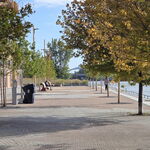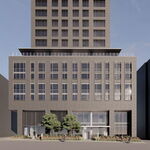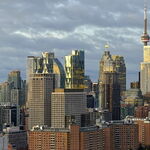Government of Canada Invests in AGO’s Weston Family Learning Centre
Hariri Pontarini Architects tabbed for design
(TORONTO - February 22, 2010) The Art Gallery of Ontario's much anticipated Weston Family Learning Centre received a major boost from the federal government with today's announcement of a $7.5 million funding contribution from the government's Infrastructure Stimulus Fund.
Toronto firm Hariri Pontarini Architects has been selected to design the new centre, which will occupy space within the AGO's existing footprint. The firm's many educational, commercial and residential projects include the award-winning Schulich School of Business and McKinsey & Company office building in Toronto.
Plans for the 35,000 square-foot Learning Centre were crystallized in late 2008 following on the announcement of a lead gift of $12 million from The W. Garfield Weston Foundation. The gift included $10 million toward capital costs for the Learning Centre and $2 million toward an endowment to be named the Weston Foundation Teacher Training Fund - the AGO's first education program endowment.
"With this investment, the Government of Canada recognizes the importance of arts education to our city and province," said Robin Young, AGO Trustee and chair of the AGO's Education Committee. "In the Weston Family Learning Centre, the Art Gallery of Ontario will create an innovative, one-of-a-kind resource for Canadians to share for years to come."
"The AGO is able to match the government's investment thanks to the generosity of the W. Garfield Weston Foundation, which committed the largest single gift in support of art education in the Gallery's 110-year history," says Matthew Teitelbaum, the AGO's Michael and Sonja Koerner director, and CEO. "We are profoundly grateful for the Foundation's support and its extraordinary vision."
Founded in 1930 by Group of Seven artist and teacher Arthur Lismer, today's AGO education and community programming serves more than 100,000 youth, families, adults and educators, providing curriculum enrichment, art classes, community outreach and teacher training.
When completed, the Weston Family Learning Centre will enable the Gallery to increase participation in art education for all ages with dedicated spaces for art instruction, workshops and community-based exhibitions. It will be a fully wireless, networked facility with integrated technology throughout. State-of-the-art seminar rooms will feature broadcast and videoconferencing capabilities. The Learning Centre will reach out to students and teachers in their classrooms through online interactive technologies. The Weston Foundation Teacher Training Fund will support on site and on-line workshops and professional development for teachers.
Design development for the Learning Centre will be underway by next month, with construction to begin in April. Completion of the Weston Family Learning Centre is anticipated by 2011.
ABOUT THE AGO
With a permanent collection of more than 79,000 works of art, the Art Gallery of Ontario is among the most distinguished art museums in North America. In 2008, with a stunning new design by world-renowned architect Frank Gehry, the AGO opened its doors to the public amid international acclaim. Highlights include Galleria Italia, a gleaming showcase made of wood and glass running the length of an entire city block along the Gallery's façade; and the feature staircase, spiraling up through the roof of Walker Court and into the new contemporary galleries above. From the extensive Group of Seven collection to the dramatic new African art gallery; from the cutting edge works in the David and Vivian Campbell Centre for Contemporary Art to Peter Paul Rubens' masterpiece The Massacre of The Innocents, a highlight of the celebrated Thomson Collection, there is truly something for everyone at the AGO.
- 30 -
For more images and more information contact:
Susan Bloch-Nevitte, 416-979-6660, ext. 260,
susan_bloch-nevitte@ago.net
Sean O'Neill, 416-979-6660 ext. 403,
sean_oneill@ago.net
Amanda Gabriele, 416-979-6660, ext. 372,
sean_oneill@ago.net
Antonietta Mirabelli, 416-979-6660 ext. 454,
antonietta_mirabelli@ago.net
The Art Gallery of Ontario is funded in part by the Ontario Ministry of Culture. Additional operating support is received from the Volunteers of the AGO, the City of Toronto, the Department of Canadian Heritage and the Canada Council for the Arts.














